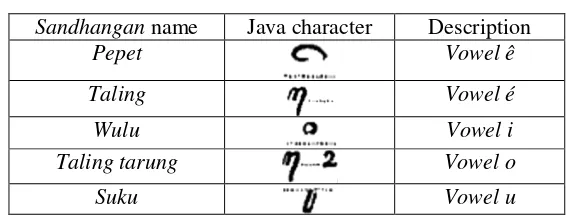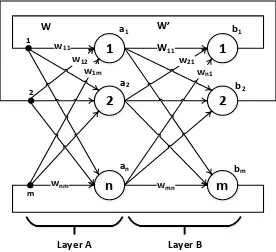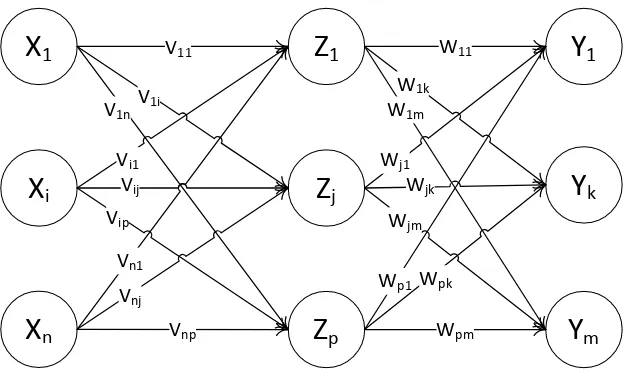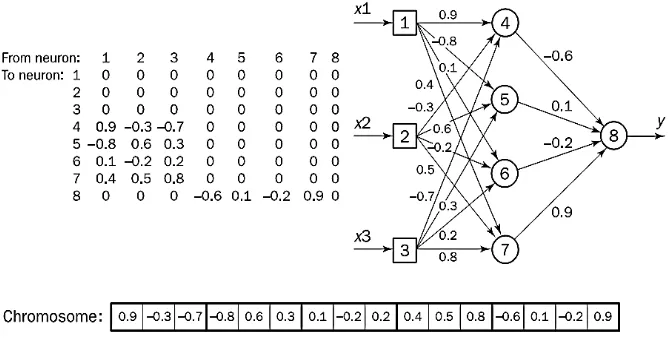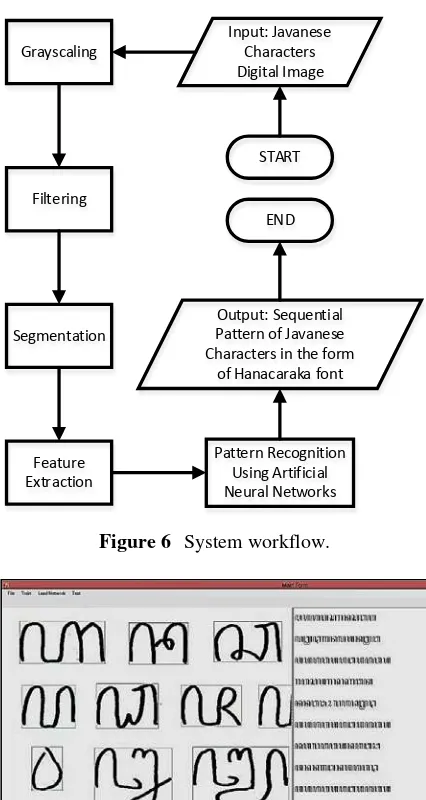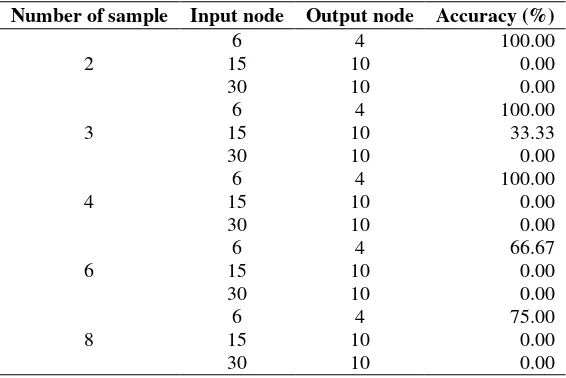Received October 28th, 2014, Revised February 2nd, 2015, Accepted for publication February 13th, 2015. Copyright © 2015 Published by ITB Journal Publisher, ISSN: 2337-5787, DOI: 10.5614/itbj.ict.res.appl.2015.8.3.2
Handwritten Javanese Character Recognition Using
Several Artificial Neural Network Methods
Gregorius Satia Budhi, Rudy Adipranata
Informatics Department, Petra Christian University Jalan Siwalankerto 121-131, Surabaya 60236, Indonesia
Email: [email protected]
Abstract. Javanese characters are traditional characters that are used to write the Javanese language. The Javanese language is a language used by many people on the island of Java, Indonesia. The use of Javanese characters is diminishing more and more because of the difficulty of studying the Javanese characters themselves. The Javanese character set consists of basic characters, numbers, complementary characters, and so on. In this research we have developed a system to recognize Javanese characters. Input for the system is a digital image containing several handwritten Javanese characters. Preprocessing and segmentation are performed on the input image to get each character. For each character, feature extraction is done using the ICZ-ZCZ method. The output from feature extraction will become input for an artificial neural network. We used several artificial neural networks, namely a bidirectional associative memory network, a counterpropagation network, an evolutionary network, a backpropagation network, and a backpropagation network combined with chi2. From the experimental results it can be seen that the combination of chi2 and backpropagation achieved better recognition accuracy than the other methods.
Keywords: backpropagation; bidirectional associative memory; chi2; counterpropagation; evolutionary neural network; Javanese character recognition.
1 0BIntroduction
Many people on the island of Java use the Javanese language in their conversation. The Javanese language has its own letterforms that differ from Roman characters. Javanese character recognition has its own difficulties because of the shapes of the basic characters, vowels, complementary characters, and so on. Because the characters are difficult to recognize, not many people can read or write Javanese script any more. For many people, Javanese characters will eventually be regarded as decoration only and not mean anything. This will gradually erode the existence of Javanese characters and will ultimately also affect Javanese culture in general.
text using a Hanacaraka font. The first process is digital image preprocessing, followed by segmentation and feature extraction. The features will be used as input for the recognition system. In this research we used and compared five methods of artificial neural networks for recognition, namely a bidirectional associative memory network, a counterpropagation network, an evolutionary neural network, a backpropagation neural network, and a combination of chi2 and a backpropagation neural network.
In addition to serving as the basis of further research, we hope that with this system the Javanese characters can be preserved and studied more easily. The system, which makes it easy to save articles in Javanese characters to electronic documents, can also help teachers teach the Javanese language in schools. And finally for those who do not know about Javanese script, this system can be used to identify and interpret writings in Javanese characters that they encounter in touristic sites.
2 Related Works
Some researchers have conducted research on Javanese character recognition. Nurmila [1] used a backpropagation neural network. The accuracy rate was about 61%. Another researcher, Priyatma, used fuzzy logic [2] and the recognition results were satisfactory. Also in relation to Javanese character studies, Rudy, et al. [3] have developed an application that translates the results of typing on a Roman letter keyboard into Javanese characters using a
Hanacaraka font. This application can later be combined with the result of the
present research to create optical character recognition and an editor for Javanese characters. This research is an extension of previous research [4],[5], which evaluated the use of a backpropagation neural network for character recognition and some improvement in digital image preprocessing.
Several studies on the implementation of artificial neural networks have also been done, including automatic classification of sunspot groups for space weather analysis [6] using backpropagation and other neural network methods. Other studies have used backpropagation methods to recognize types of automobiles [7], to identify abnormalities of the pancreas through the image of the iris with a recognition rate of more than 90% [8], and to recognize characters in a digital image [9].
3 Javanese characters
Figure 1 Basic (carakan) characters.
Numbers in Javanese characters are shown in Figure 2 [11].
Figure 2 Javanese symbols for numbers.
Sandhangan characters are special characters that are used as complementary
characters, vowels or consonants that are commonly used in everyday language.
Sandhangan can be seen in Table 1 [12].
Table 1 Sandhangan characters.
Sandhangan name Java character Description
Pepet Vowel ê
Taling Vowel é
Wulu Vowel i
Taling tarung Vowel o
Suku Vowel u
4 Image Segmentation
made clearly visible, segmentation should be discontinued [13]. In this research, we used thresholding and skeletonizing for the segmentation process.
Thresholding is one way of separating objects (foreground) in an image from the background by selecting a threshold value T. In thresholding, the value of T is used to separate all points (x, y) in an image in two categories. All points (x,y), where f (x, y) > T, can be called either an object point or a background point [13].
To get rid of redundant pixels and produce an image that is more modest in size, the skeletonizing process is used. The goal of skeletonizing is to make a simpler image, so that the shape and suitability of the image can be analyzed further. The most important problem addressed in the skeletonizing process is how to determine the redundant pixels. If we do not adequately determine the redundant pixels, the skeletonizing process is likely to turn into an erosion process, which can cause image regions to be deleted. The skeleton should have some basic properties, such as [14]:
1. The pixels that form the skeleton should be located near the middle area of the region’s cross section.
2. It must consist of several thin regions, with each region having a width of only 1 pixel.
3. Skeletal pixels must be connected to each other to form several regions and the number of those regions should be equal to the number of regions in the original image.
5 Bidirectional Associative Memory
In 1988 Bart Kosko proposed an artificial neural network called bidirectional associative memory (BAM) [15]. BAM is a hetero-associative and content-addressable memory. A BAM network consists of two bipolar binary layers of neurons, say A and B. The neurons in the first layer (A) are fully interconnected to the neurons in the second layer (B). There is no interconnection between neurons in the same layer. Because the BAM network processes information in time and it involves bidirectional data flow, it differs in principle from a linear association, although both networks are used to store association pairs [16]. A general diagram of BAM is shown in Figure 3.
BAM algorithm [16]:
Step 1: The associations between pattern pairs are stored in the memory in the form of bipolar binary vectors with entries -1 and 1.
Vector a stores a pattern and is n-dimensional, while vector b is m-dimensional and stores the associated output.
1
2
n
1
2
m
wnm wmn
w11 W11
w12 w1m
w21 wn1
W W’
1
2
m
a1 b1
a2 b2
an bm
Layer A Layer B
Figure 3 Bidirectional Associative Memory: General Diagram.
Step 2: Calculate weight using Eq. (2).
𝑊=∑𝑝 𝑎(𝑖)
𝑖=1 𝑏(𝑖)𝑡 (2)
Step 3: The test vector pair a and b is given as input.
Step 4: In the pass forward, b is given as input. Calculate a using Eq. (3).
𝑎=Γ[𝑊𝑏] (3)
Calculate each element of vector a using Eq. (4).
𝑎𝑖′=𝑠𝑔𝑛�∑𝑗=1𝑚 𝑤𝑖𝑗𝑏𝑗�,𝑓𝑜𝑟𝑖= 1, 2, … ,𝑛 (4)
Step 5: Vector a is now given as input to the second layer during the backward pass. Calculate the output of this layer using Eq. (5).
𝑏′=Γ[𝑊𝑎] (5)
𝑏𝑗′=𝑠𝑔𝑛�∑ 𝑤 𝑖𝑗𝑎′𝑖 𝑛
𝑖=1 �,𝑓𝑜𝑟𝑗= 1, 2, … ,𝑚 (6)
Step 6: Stop the process if there is no further update. Otherwise repeat step 4 and 5.
BAM storage capacity:
The maximum number of pattern pairs that can be stored and successfully retrieved is min (m, n). This estimate is heuristic. The memory storage capacity of BAM [16] is
P ≤ min (m, n) (7)
6 Counterpropagation Network
In 1987, Robert Hecht-Nielsen defined the counterpropagation network (CPN). The CPN is widely used because of its simplicity and ease of the training process. It also has good stats in the representation of the input layer for a wide range of environments. It combines an unsupervised training method on the Kohonen layer and a supervised training method on the Grossberg layer [17].
6.1 Forward Only Counterpropagation
The training for forward-only counterpropagation is the same as training for full counterpropagation. It consists of two phases; the first phase should be completed before proceeding to the second phase. The first phase is Kohonen learning and the second phase is Grossberg learning. In Figure 4 we can see the forward-only counterpropagation network architecture.
Only the winner unit is allowed to learn or update the weights in the learning phase of the Kohonen training. The minimum distance between the weight vector and the input vector is calculated to determine the winning unit. Either Eqs. (8) or (9) can be used to calculate the distance between two vectors:
Dot Product ( z_inj = ∑ xi vij + ∑ yk wkj) (8)
Euclidean Distance ( Dj = ∑ (xi – vij)2 + ∑ (yk – wkj)2 ) (9)
When using dot product, look for results that have the largest value, because the larger the value of dot product, the smaller the angle between two vectors will become, provided that both vectors are normalized. When using Euclidean distance, look for results that have the smallest value, because Euclidean distance calculates the physical distance between the two vectors.
The training algorithm for forward-only counterpropagation is as follows [18]:
Step 0 : Initialize learning rate and all weights.
Step 1 : Do step 2-7 as long as the stop condition of the first phase is not met. Step 2 : Do step 3-5 for each pair of input x:y.
Step 3 : Enter input vector x in input layer X.
Step 4 : Find the winner of the Kohonen layer unit, save its index into variable J.
Step 5 : Update weight for unit Zj using Eq. 10
vijnew = (1 - α)vijold + αxi , i = 1 . . . n (10)
Step 6 : Decrease the learning rate (α).
Step 7 : Check if the stop condition is met for the first phase.
Step 8 : Do step 9-15 as long as the stop condition of the second phase has not been met (α and β are very small and constant during the second phase).
Step 9 : Do step 10-13 for each pair of input x:y. Step 10 : Enter input vector x in input layer X.
Step 11 : Find the winner of the Kohonen layer unit, save its index into variable J.
Step 12 : Update the weights that go into Zj using Eq. (11).
vijnew = (1 - α)vijold + αxi , i = 1 . . . n (11)
Step 13 : Update the weights from Zj to the output layer using Eq. (12).
wjknew = (1 - α)wjkold + αyk , k = 1 . . . m (12)
Step 14 : Decrease the learning rate (α).
After the training process has been completed, the forward-only counterpropagation network can be used to map x into y using the following algorithm [18].
Step 0 : Use the weight training results. Step 1 : Enter input vector x in input layer X. Step 2 : Find the winner index unit, save in J. Step 3 : Calculate output using Eq. (13).
Yk = wjk (13)
7 Evolutionary Neural Network
An evolutionary neural network (ENN) is a combination of a neural network with an evolutionary algorithm. A common limitation of neural networks is associated with network training. Backpropagation learning algorithms have serious drawbacks, which cannot guarantee that the optimal solution is given. Another difficulty in neural network implementation is related to selecting the optimal network topology. Network architecture that is appropriate for certain cases are often chosen using heuristic methods. This shortcoming can be addressed using an evolutionary algorithm.
Evolutionary algorithms refer to a probabilistic adaptation algorithm inspired by natural evolution. This method follows the statistical search strategies in a population of individuals, each representing a possible solution to the problem. Evolutionary algorithms can divided into three main forms, namely evolution strategies, genetic algorithms, and evolutionary programming [19].
The evolutionary algorithm used in this research is a genetic algorithm. The genetic algorithm is an effective optimization technique that can help both optimizing the weight and selecting the network topology. A problem must be represented as a chromosome in order to use a genetic algorithm. When we want to look for a set of optimal weights of a multilayer feed-forward neural network, the first step in solving this problem is to have the system encode the network into a chromosome. This process can be seen in Figure 5 [20].
The genetic algorithm seeks to find the set amount of weight that has the smallest squared errors.
Figure 5 Encoding a network into a chromosome.
The third step is to choose the genetic operators crossover and mutation. The crossover operator requires two parent chromosomes and creates a child with genetic material from both of its parents. Each gene of the child chromosome is represented by the corresponding genes of a randomly selected parent. The system is ready to apply the genetic algorithm when the mutation operator randomly selects a gene and replaces it with a random result between -1 and 1. Users need to define the number of networks with different weights, the probability of crossover and mutation, the population number and the number of generations [20].
8 ICZ-ZCZ
Image centroid and zone (ICZ) and centroid zone and zone (ZCZ) are feature extraction methods that utilize the type of zoning and zone centroid of the zones that an image has been divided into. These methods begin with dividing an image into several equal zones.
9 Backpropagation
A backpropagation neural network is a neural network that uses a multilayer feed-forward architecture. This method is widely used to solve many problems, such as classification, pattern recognition and generalization [22].
The training algorithms in backpropagation are as follows [23]:
Feed-forward phase (7 steps):
Step 0 : Initialize weight (random value between 0-1) and learning rate α Step 1 : Do step 2-13 as long as the stop condition is not met
Step 2 : Perform steps 3-13 as the desired amount of training Step 3 : Do steps 4-13 for each hidden layer and output layer
Step 4 : Calculate the input of each node in the hidden layer using Eq. (14).
1
Step 5 : Calculate the output of each node in the hidden layer activation function using Eqs. (15) and (16)
Step 6 : Calculate the input of each node in the output layer using Eq. (17)
1
Step 7 : Calculate the output at each node in the output layer using Eq. (18)
( _ )
k k
y = f y in
(18)
Error-backpropagation phase (6 steps):
Step 8 : Calculate the error of each node in the output layer with the deactivation function using Eqs. (19) and (20)
*
jk k
w α δ
∆ =
(21)
Step 10 : Calculate the error for each node in the hidden layer to deactivate the function using Eq. (22)
Step 11 : Calculate the change in weight for each node in each hidden layer using Eq. (23)
*
ij j
w α δ
∆ = (23)
Step 12 : Update the weight for each node in the output layer using Eq. (24)
( ) ( )
jk jk jk
w new =w old + ∆w (24)
Step 13 : Update the weight for each node in each hidden layer using Eq. (25)
( ) ( )
jk jk jk
w new =w old + ∆w (25)
10 Chi2
The Chi2 algorithm [24] is an algorithm that uses the χ2 statistic to discretize numeric valued attributes. This algorithm is quite effective if used in the selection of the important features of a group of numerical attributes. By using the features that are relevant, this algorithm can speed up the training process and improve the prediction accuracy of classification algorithms in general. Additionally, there are many classification algorithms that require and work better on discrete training data.
In use, the Chi2 algorithm is divided into two phases. The first phase begins with a high enough significance value, e.g. 0.5, for all attributes for discretization. The process of merging the data will continue for as long as χ2 does not exceed the specified significance value (0.5, yielding a value 0.455 with degree of freedom equal to 1). This phase will be repeated, reducing the significance value until the number of inconsistent data in the discretization exceeds the specified limit. The equation to calculate the value of χ2 can be seen in Eq. (26).
Aij = number of pattern at interval - i, classification - j
Eij = the pattern expected from Aij = Ri* Cj⁄N, if Ri or Cj equal to 0,
Eij should change to 0.1
Ri = number of pattern at interval - i = ∑kj=1Aij
Cj = number of pattern at interval - j =∑2𝑖=1𝐴𝑖𝑗
N = total number of pattern = ∑2𝑖=1𝑅𝑖
The second phase is an optimization of the first phase. The most visible difference is the calculation of inconsistency. Calculation is done after all the attributes have gone through the merger process in the second phase. The inconsistency value is calculated at the end of each attribute discretization while in the first phase. The second phase will be repeated until there are no longer any values of attributes that can be discretized or combined. Inconsistency occurs when there are several samples with all of their attributes having the same value but they belong to different groups.
11 Design and Implementation
The input for the system is a Javanese character digital image. Grayscale processing and filtering are done to reduce noise. Subsequently, we apply skew detection and correction to straighten skewed images. Later, the segmentation process is executed to get each Javanese character using thresholding and skeletonizing. Feature extraction is done using ICZ-ZCZ [21] and the features will be used as inputs for the artificial neural network.
Each Javanese character image is divided into 4*5 zones, after which ICZ-ZCZ will be performed for each zone, so there are 40 ICZ-ZCZ output values. These values will later become artificial neural network input nodes.
The overall system workflow can be seen in Figure 6.
The application interface is shown in Figure 7.
START Input: Javanese
Characters Digital Image Grayscaling
Filtering
Segmentation
Feature Extraction
Pattern Recognition Using Artificial Neural Networks Output: Sequential Pattern of Javanese Characters in the form
of Hanacaraka font END
Figure 6 System workflow.
Figure 7 Application interface.
11.1 Dataset for the Experiment
each character. There are in total 31 Javanese characters, so the overall number of data was 620 characters. The dataset for testing also consisted of 20 sample data for each Javanese character, with the overall data being 620 characters. Examples of the sample data can be seen in Figure 8. Every sample data was processed by feature extraction using the ICZ-ZCZ method. The 40 value results of the feature extraction became the inputs for 40 nodes of the neural network input neurons.
Figure 8 Examples of data samples for training and testing process.
12 Experimental Results
For pattern recognition of Javanese characters, we used five kinds of artificial neural networks, namely bidirectional associative memory, counterpropagation, evolutionary, backpropagation and backpropagation combined with chi2.
The experimental results of bidirectional associative memory (BAM) can be seen in Table 2.
Table 2 Experimental Results of BAM.
Number of sample Input node Output node Accuracy (%)
2
6 4 100.00
15 10 0.00
30 10 0.00
3
6 4 100.00
15 10 33.33
30 10 0.00
4
6 4 100.00
15 10 0.00
30 10 0.00
6
6 4 66.67
15 10 0.00
30 10 0.00
8
6 4 75.00
15 10 0.00
From the experimental results above, we can see that BAM was inaccurate when applied to Javanese character recognition. This is because we needed at least 40 nodes for the input, while BAM only works well when the number of inputs is the same as or less than 6 nodes. For the output we needed 31 nodes in this experiment because the total number Javanese characters is 31, while BAM only works well for 4 nodes or less.
Another experiment used a counterpropagation network (CPN), a backpropagation network (BPNN) and an evolutionary neural network (ENN) with 1 layer and 2 layers. We performed the experiment using a dataset that had been trained beforehand and a dataset that had not been trained beforehand.
The neural network output layer consisted of 31 neurons. These 31 neurons were in accordance with the number of Javanese characters used in this research: 20 basic (carakan) characters, 4 sandhangan characters, and 7 number characters (not all 10 number characters, because 3 number characters have the same form as carakan characters). Each neuron has a value of 0 or 1. For the first character, the first neuron is 1, while the other neurons are 0. For the second character, the second neuron is 1, while the other neurons are 1, etc. The number of neurons in the other layer is 60.
From the experimental results it can be seen that the average recognition accuracy of CPN was only about 71% for trained data and 6% for test data (data had not been trained beforehand). The average recognition accuracy of ENN was about 94% for trained data and about 66% for test data. The parameters used for ENN were: the number of neurons for each layer: 60, crossover probability: 100%, mutation probability: 50%, maximum population: 50, maximum epoch: 10 million, and error limit: 0.1. The average recognition accuracy of BPNN was about 79% for trained data and 33% for test data. The parameter used for BPNN: input neurons: 40, learning rate: 0.1, error threshold: 0.001.
experiment using data that had been trained beforehand and Table 4 for the experiment using test data.
Table 3 Experimental results using trained data.
Javanese
Table 4 Experimental results using test data.
Javanese
In this research, we have developed a handwritten Javanese character recognition system using several artificial neural network methods and compared their recognition results. From the experiment that has been executed it can be concluded that the bidirectional associative memory method and the counterpropagation network method cannot be used for recognition of Javanese characters because their average accuracy was very low. The combination of the Chi2 method and the backpropagation neural network method performed better than the evolutionary neural network method with 1 layer or 2 layers for Javanese character recognition. Its recognition accuracy rate reached 98% for data that had been trained beforehand and 73% for data that had not been trained beforehand. For future research, the accuracy rate may be improved by using another method for segmentation and feature extraction that can better distinguish similar Javanese characters. Also a combination of Chi2 and ENN may be used to improve accuracy.
Acknowledgments
This research was also funded by Research Center, Petra Christian University, Surabaya, Indonesia, through the Internal Research Grant (05/Pen-LPPM/UKP/2012), fiscal year 2012. We also thank Edwin Prasetio Nandra, Danny Setiawan Putra, Eric Yogi Tjandra, Evan Sanjaya, Jeffry Hartanto, Ricky Fajar Adi Edna P., and Christopher H. Imantaka for their help in doing the system coding.
References
[1] Nurmila, N., Sugiharto, A. & Sarwoko, E.A., Back Propagation Neural
Network Algorithm for Java Character Pattern Recognition, Jurnal
Masyarakat Informatika, 1(1), pp. 1-10, 2010.
[2] Priyatma, J.E. & Wahyuningrum, S.E., Java Character Recognition
Using Fuzzy Logic, SIGMA, 8(1), pp. 75-84, 2005.
[3] Adipranata, R., Budhi, G.S. & Thedjakusuma, R., Java Characters Word
Processing, in Proceeding of The 3rd International Conference on Soft
Computing. Intelligent System and Information Technology, Bali, Indonesia, 2012.
[4] Budhi, G.S. & Adipranata, R., Comparison of Bidirectional Associative Memory, Counterpropagation and Evolutionary Neural Network for Java
Characters Recognition, in Proceedings of The 1st International
Conference on Advanced Informatics: Concepts, Theory and Applications, Bandung, Indonesia, 2014.
[5] Budhi, G.S. & Adipranata, R., Java Characters Recognition using Evolutionary Neural Network and Combination of Chi2 and
Backpropagation Neural Network, International Journal of Applied
Engineering Research, 9(22), pp. 18025-18036, 2014.
[6] Adipranata, R., Budhi, G.S. & Setiahadi, B., Automatic Classification of
Sunspot Groups for Space Weather Analisys, International Journal of
Multimedia and Ubiquitous Engineering, 8(3), pp. 41-54, 2013.
[7] Budhi, G.S., Adipranata, R. & Jimmy Hartono, F., The Use of Gabor Filter and Backpropagation Neural Network for Automobile Types
Recognition, in Proceeding of The 2nd International Conference on Soft
Computing, Intelligent System and Information Technology, Bali, Indonesia, 2010.
[8] Budhi, G.S., Purnomo, M.H. & Pramono, M., Recognition of Pancreatic Organ Abnormal Changes Through Iris Eyes Using Feed-Forward
Backpropagation Artificial Neural Network, in Proceeding of The 7th
National Conference on Design and Application of Technology, 2008. [9] Budhi, G.S., Gunawan, I. & Jaowry S., Backpropagation Artificial
Neural Network Method for Recognition of Characters on Digital Image,
[10] Java Character Hanacaraka, http://nusantaranger.com/referensi/buku-elang/chapter-4merah/aksara-jawa-hanacaraka/, last access October 2014.
[11] Javanese Alphabet (Carakan), http://www.omniglot.com/writing/
javanese.htm (October 2014).
[12] Java Characters, http://id.wikipedia.org/wiki/Aksara_Jawa (January
2013).
[13] Gonzalez, R.C. & Woods, R.E., Digital Image Processing, 3rd Edition, New Jersey: Prentice-Hall, Inc., 2008.
[14] Parker, J.R., Algorithm for Image Processing and Computer Vision, New York: John Wiley and Sons, Inc., 2010.
[15] Kosko, B., Bidirectional Associative Memories, IEEE Transactions on Systems, Man, and Cybernetics, 18(1), pp. 49-60, 1988.
[16] Singh, Y.P., Yadav, V.S., Gupta, A. & Khare A., Bi Directional Associative Memory Neural Network Method In The Character
Recognition, Journal of Theoretical and Applied Information Technology,
5(4), pp. 382-386, 2009.
[17] Boyu, W., Feng W. & Lianjie S., A Modified Counter-Propagation
Network for Process Mean Shift Identification, in Proceeding of IEEE
International Conference on Systems, Man and Cybernetics, pp. 3618-3623, 2008.
[18] Fu, L.M., Neural Networks in Computer Intelligence, New York: McGraw-Hill, Inc, 1994.
[19] Dewri, R., Evolutionary Neural Networks: Design Methodologies, http://ai-depot.com/articles/evolutionary-neural-networks-design-method ologies/ (January 2013).
[20] Negnevitsky, M, Artificial Intelligence: A Guide to Intelligence Systems (2nd ed.), New York: Addison Wesley, 2005.
[21] Rajashekararadhya, S.V. & Ranjan, P.V., Efficient Zone Based Feature Extraction Algorithm for Handwritten Numeral Recognition of Four
Popular South Indian Scripts, Journal of Theoretical and Applied
Information Technology, 4(12), pp. 1171-1181, 2005.
[22] Rao, H.V. & Valluru B.R., C++ Neural Networks and Fuzzy Logic, New York: Henry Holt and Company, 1993.
[23] Fausett, L., Fundamentals of Neural Networks, New Jersey: Prentice Hall, 1994.
[24] Liu, H. & Setiono, R., Chi2: Feature Selection and Discretization of
Numeric Attributes, In Proceeding of The 7th International Conference on
